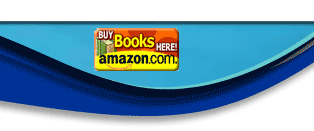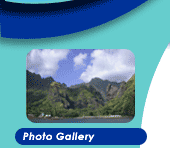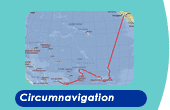February 25, 2002
|
Of course, everything starts with a list. Due to the
very short time we had in Canet, France for sea trials, we had compiled
a list of issues, which needed to be corrected in San Diego under warranty,
even before we left. During our passage across the Atlantic, the list
of problems grew even longer. After our arrival in St. Lucia, Catana
sent two technicians over to correct many of the smaller problems, leaving
the bigger ones until Pacific Bliss arrived San Diego. We arrived in
San Diego with a list of 58 items to be taken care of under warranty.
I am happy to report that the last one, replacing the trampoline, which
was recalled by the factory, has recently been completed. We had great
cooperation from Catana through our broker David Renouf and Catana's
U.S. rep John Saucerman. To our satisfaction, we did not have to argue
about one single item on our list. That was great. But the warranty repairs were only the beginning. As the sun drenched days turned into the coolest winter I've ever spent in San Diego, I wrestled with another type of list, the list of our own necessities, wishes and dreams. Many of the 31 items on this list were suggested by Lois and have been debated about and, sometimes, rejected, like a generator set to provide power for an air conditioning unit; I argued that we have already two engines aboard and that I refuse to take responsibility for a third one. That shot down the air conditioning. OK, we know how to sweat it out. We somehow survived the stifling days in the Banana Bay Marina in Golfito, Costa Rica. Between noon and 1500 hours we just got naked, closed all the shades on the windows, moistened our bodies once in a while with a cool washcloth, and rested in our master cabin, reading or napping. That's a good low-tech solution, of the kind I like. Other things needed to be done without discussion; for example, we had to add a third anchor and beef up our first anchor. Dragging the anchor at night in a storm in a crowded anchorage towards a rocky shore is a cruiser's worst nightmare. Like a women never being too thin or too rich (or at least too rich), you never can have enough anchors out with a long rode preferably made from heavy chain. That makes for a good night's rest. I will never forget our anchoring situation in the San Blas island of Mamitupu, where we anchored close to a reef on our bow, the island's village close to our port, and a thatched roof house on a little island right behind our stern. At night, the wind freshened up to Force 6, about 25 knots, with Pacific Bliss dancing wildly on the whitecaps. We had four on board and each one of us had come up during the night to check the holding, fearing that we would drag and end up on the rocks behind us, smashing into the hut-no larger than our boat--of the family living on it. We were OK, but the next day I found the shackle on the bridle that attaches to the anchor chain, quite bent, but still holding. There had been a tremendous force on the anchor chain! A catamaran has more surfaces exposed to the wind and will exert more strain on the anchor gear than a monohull. That is one of the trade-offs to the comfort of a multihull. Since we plan to stay in the South Pacific for a long time, we need to have ample spare parts on board: fuses, batteries, light bulbs, hoses, screws, filters of all kind, engine oil, engine parts, auto helm parts, more tools, etc. All this requires diligent study of the inventory and making sub lists of lists. I kind of enjoy going down to Pacific Bliss--secured at the yacht brokerage dock in the boatyard--and mull over all the little and big things which the boat might need just in case. Hopefully, many things will never be used, but an inventory of spare parts is like a car insurance policy: You are not unhappy that you paid for it and never had an accident. Then there were bigger things to discuss with Lois, like a washing machine. We had space provided for it and had the plumbing installed at the factory in Canet, but we were waiting to buy it in San Diego. This is an issue I lost to Lois: My low-tech solution of dragging the laundry behind the boat in netting was rejected. I also tried to make a point that not much laundering is needed on a cruise; one applies the method of relative cleanliness; once you think something is dirty, put it into a bag. When you are out of clothes, go to the bag and start wearing it again, because now it's relatively clean. Also, turning underwear inside out extends the clean life by a factor two. Anyway, because we have a clothing optional boat, we also will need more suntan lotion than coverings. All this persuasion was in vain. What won out in the end is the specter of facing $50 laundry bills in Papeete, money which we would rather spend on French wine. For our navigational needs (Lois is the official Navigator), we needed a complete new set of charts and guidebooks. We have already some and are studying nice anchorages, a nice way to dream your time away. I also added an electronic chart system on a laptop, because I cannot get charts for the South Pacific for my built-in B&G electronic chart plotter. The new chart system also works with my two handheld GPS. We added a propane-powered barbecue, a night vision monocular and a good second pair of binoculars with built-in compass and range finder. I had a second alternator installed on the starboard engine, which will double the SB charging current from 50 amps to 100 amps. With both engines, I can have 150 amps charging current. I upgraded our tool box substantially; the factory supplied tools were of poor quality; a large screwdriver broke after the first use. Several power tools were added too. Lots of thinking went into the selection of a better worldwide communications system. The (cheap) sailmail system I bought for e-mail never worked on voyage 1 and gave me a lot of frustrations, though I got it to work in San Diego with the help of an expert. I learned that the IRIDIUM system was resurrected from the dead and is now stable due to its contracts with the U.S. Department of Defense. The company provides worldwide voice and data at more reasonable costs than Inmarsat C and M, so we ordered one. Last not least, we wanted to have more shelving in cabins, bilges and lockers for easier storage and access. This required diligent design studies and many discussions with a carpenter, but all the work has been completed and we are both happy with the built-in look to it all. A nice addition is a breadmaker, now that we tried it out on board and found that the drain on the battery bank is acceptable. I look forward to tasty fresh bread on long passages; the smell alone is great. If the crew does not use the breadmaker often enough, I figure that I can always use it as a fourth, emergency anchor. It weighs enough! We had all the varnishing of the woodwork done twice by a professional; two people spent about a week applying one coat after the other to the wooden parts of Pacific Bliss. It was expensive but it paid off in pretty looks and, hopefully, in endurance. All this sounds like a lot of work, and it is, because people working on boats share the free spirit of the sea: they might come or not, might work or not, though most of them have a great sense of humor and like boats and like to talk about them. I am always happy to hear them admire our pretty Pacific Bliss. I feel driven to go visit Pacific Bliss almost every day. Just sitting in the cockpit or on the pulpit seat watching other boats drift by and share a wave with another skipper makes me happy and light hearted. In such moments the heavy burden on my soul caused by the tragic events of 9/11 lifts somewhat. The thought that we might not be welcome anymore in some of our sailing destinies like Indonesia and Malaysia, however, casts a shadow on our plans. I only hope that time will heal the wounds inflicted in so many people and lessen the hate for Americans which is creeping up in so many corners of the world. So, that is why doing and completing little things on the boat is needed to soothe the soul and give a sense of achievement and control in my little corner of the world. Contemplating Cruising by Lois Joy, San Diego, California July 9, 2000 Messing with Boats, Part I by Gunter Messing with Boats, Part 2 by Lois Messing with Boats, Part 4 by Lois The Anchor Story, By Lois and Gunter
|
journal52.html |
|
|











